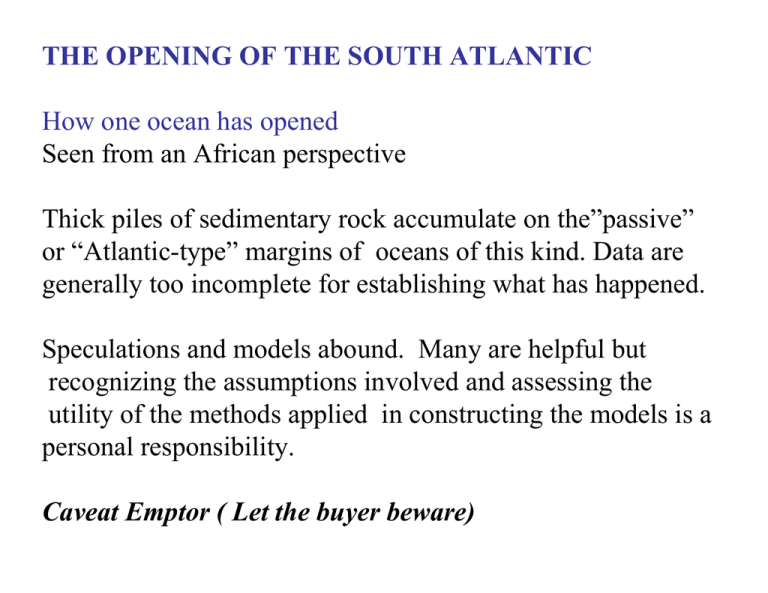Document 13507378
advertisement

THE OPENING OF THE SOUTH ATLANTIC How one ocean has opened Seen from an African perspective Thick piles of sedimentary rock accumulate on the”passive” or “Atlantic-type” margins of oceans of this kind. Data are generally too incomplete for establishing what has happened. Speculations and models abound. Many are helpful but recognizing the assumptions involved and assessing the utility of the methods applied in constructing the models is a personal responsibility. Caveat Emptor ( Let the buyer beware) HOW TIGHTLY CAN OCEANS BE CLOSED ? Classic studies from the north side of the Bay of Biscay, where there is very little post-rift sediment, showed listric normal faults and flow of the continental crust at depth. Both accommodated extension. The transition between continent (ca.35 km continental crust) and ocean-floor (ca.10 km basaltic crust) showed a ca.150 km wide transitional region. The conjugate shore transition zone is likely to have been narrower. Too many terms are used e.g.:” rifted and thinned continental Crust”, “ stretched continental crust” “Transitional crust” and “proto-oceanic crust”. Some see two or more varieties of crust. (1)MOST SOUTH ATLANTIC INTRA-CONTINENTAL RIFTS WERE INITIATED 140 Ma +/- 5 (mid-Berriasian). (IN K-pippe) (2) THEY EVOLVED AS INTRA-CONTINENTAL RIFTS TILL ca. 125 Ma (Late Barremian) WHEN OCEAN FLOOR BEGAN TO FORM. (3)WHAT IS NOW THE TRISTAN PLUME ERUPTED AT ca 133 Ma (Hauterivian) TO FORM PARANA (S. AMERICA) AND ETENDEKA ( Africa) LARGE IGNEOUS PROVINCES. (4) OCEAN FLOOR BEGAN TO FORM ALL THE WAY FROM DURBAN TO THE DEMERARA RISE (at 125 +/- 3 Ma within BARREMIAN times.) M 9 130 Ma? M8: 129, M2:124 Ma). (5) EVAPORITES WERE DEPOSITED ON OCEAN FLOOR (UNDER AIR) NORTH OF THE TRISTAN PLUME TRACK AND IN NEARBY CONTINENTAL MARGIN RIFTS AT 112 Ma (Late Aptian). (6) RIFT SHOULDERS WERE ERODED BY ca. 90 Ma. (7) SUBSEQUENT TECTONIC PERTURBATIONS AND THE ELEVATION OF ERODABLE AREAS IN SOUTH AMERICA HAVE BEEN DOMINATED BY EVENTS IN THE ANDES. (8) FOR AFRICA THE SANTONIAN (C.84 Ma) AND AFRICA ARREST EVENTS (30 Ma) HAVE BEEN TECTONIC DRIVERS SINCE THE TRISTAN HOT SPOT TRACK WAS BREACHED Rifted and thinned continent with listric faults. 150-200 km wide Offshore ANGOLA Continent to Ocean transition north of Walvis ridge where ocean floor formed under air from 126-112 Ma. Sea water then spilled in to form a 1M sq.km area of evaporites. BEST :From Durban to Guinea Nose the start of Ocean formation was between 131 and 124 Ma (128 +/- 4 Ma) Burke et al. 2003 Macmillan 2003 Fig.5,Tikku & Marks, Neves 1989 Africa and South America began to separate OLDEST SOUTH ca 126 Ma (end Barremian) about 7 My after Tristan ATLANTIC OCEAN Plume erupted and 14 My after rift initiation on the ocean site. FLOOR: •M11 (131Ma ?) Strike-slip motion began at ca 126 Ma Off Durban (Neves data) *M4 (126 Ma ? ) SOUTH Potiguar Off Namibia AMERICA AFRICA 3 anomalies strike obliquely into the shore Tristan Plume between the Cape ca 133 Ma Erupted (Hawkesworth) and the Walvis Ridge. S. Atlantic magnetics *Oldest Marine faunas ca 126 Ma Ca.126 Ma. *Subaerial ocean floor formed north of the Durban Basin magnetics ca 126 Ma (Karen Marks) Walvis ridge: No Magnetic anomalies and No marine faunas How long do escarpments at the continental margin last? Coward et al.( Ed Purdy’s strat columns1998) showed: South Atlantic rifts formed 145 ± 5 Ma. Rift deposition (pink) persisted in rifts and on ocean floor, under air, till sea water spilled in to form evaporites at 112 Ma (Late Aptian) After evaporites were deposited, carbonate deposition (blue) followed ending at 20-40 My after ocean floor began to form. This was the”Rift shoulder duration time”. Rift shoulders had been eroded by the time silici-clastic deposition (green) began at 105-90 Ma. No Long-lived escarpments Conclusion: Escarpments lasted a few tens of millions of years. Pelotas (on crest of Rio Grande Rise) and SW Africa (S.of Walvis) are different Mod. from Gallagher et al., 1998, AREPS • (1) AFT reset near coast while shoulders eroded (? 5km)(180140 and 130-80 Ma) • Too little erosion (<2km) in interior to reset AFT • Interior eroded and Africa low by 90 Ma • (2) Swell initiated at 30 • Ma.Erosion mostly outboard of newly formed Great Escarpment • Too little erosion (<2km) to reset AFT AI special ( b of scarp retreat. FT reset neaIIr coast when shoulders Modified from Gallagher et al. (1998), AREPS eroded • Too little erosion <2km in interior to reset FT • Africa flat and low by 90 Ma. In this model (1)Scarp stays fixed for > 100 My because virtually no rain falls on the crest. (2)Rivers draining inward have farther to travel and are less steep than rivers going directly to coast. Fission track predictions retreat (1) and erosion of a to For 3 models. Model 2 (3). Distinguishing applies to swell formingthe scarp Process event (active from only since Ma). A retreat the 30 later Modelerosion 1 and a later model 2 event swell event is critical. Now FT age . work for Africa and for all other rifted margins with a near coast escarpment. Great Scarps are products of erosion during the past 30 My Image courtesy of NOAA and USGS. Sirt fed by long rivers into a broad estuary Cret.desert Arabia mainly carbonates and sabkha A Atlas low lying near sea level north of this line, shoreline fluctuated rapidly 150-30 Ma sho Bulge from A to B a) ocean floor from 180 Ma b) carbonate shelf 180-125 Ma c) deltas 135-65 Ma ulde rs Europe Tan Tan Abu Gharadig thin non-marine “Nubian” and ”Hamadian” sandstones Casamance B I M Cretaceous Equator high rainfall laterites and bauxites formed between desert latitudes, silcretes and calcretes further south forest 10 m dinosaur-catching crocodiles Interior marine transgressions a) I (Iullemmeden Basin, Gao rift) five between 100 and 50 Ma b) M (Benue and Maidugari Basins) five between 100 and 50 Ma c) NEC (North East Congo) only late Cretaceous. MM (Mahura Muthla) land plants in river gravels deltas in Benue rift before 85 Ma, onto ocean floor from 80 Ma Anza NEC 80 Ma pulse Amazon until 125 Ma Lamu Delta 150-34 Ma Ogooué short rivers deltas on carbonate shelf Kalahari or Orange Delta mainly 122-95 Ma, 80 Ma pulse, little since 70 Ma) desert over much of the Congo Basin ? delta Rufiji ? early thin Kalahari sands MM marine transgression up rift? Zambezi Delta • major delta 150-65 Ma • no 65-30 Ma delta Zambezi Limpopo Tugela, 1st pulse ca. 140 Ma (no 65-30 Ma delta) 140 to R. erosion from rift shoulders Agulhas, deposition mainly in rifts 30 Ma deltas No African rifts, rivers and deltas ca. 150 Ma (LateJurassic) to 3083 MaMa (early Oligocene). 84 Ma (Santonian) tectonics not emphasized. Events Karroo like Orange, but more deposition in Cenozoic Caledon EFFECTS OF A COLLISIONAL / TRANSPRESSIONAL EVENT ON PETROLEUM SYSTEMS SANTONIAN Santonian 84-80 Ma Reversal of Kermanshah, Neyriz and Oman ophiolites PERTURBATION Traps formed, movement on emplaced by arc collision over 2000 km suture Structures Azores-Gibraltar later filled Formed transform places with hydrocarbons Sirt rifting N Africa into Atlas and compression Syrian arc Producing Traps formed, folds E-W faults Intra Africa Exploration potential Dark plate boundary Abu Gharadig folds green Casamance prospects Benue intense Cretaceous Equator folding 80-85 Ma Reservoirs deposited Doba folding Yellow in response to event ; folding Sediment sediment y rmit pulse in o f n n pulse. Rio o u c E/Guinea Anza thrusting on Muni Charcot FZ) indications of erosion in AFT record eruption of Marion Plume at 85 Ma Marion Plume dies at 60 Ma carbonatite 86 Ma rivers sediment pulse in Orange River K K K K deltas Reservoirs eroded or uplifted and exposed at Structures Surface. Breached. Probable Folding destruction of any too previously filled traps intense widespread kimberlites in S. Africa 86 Ma Tectonics, erosional, depositional and igneous events related to the Santonian event (ca. 84 Ma).





